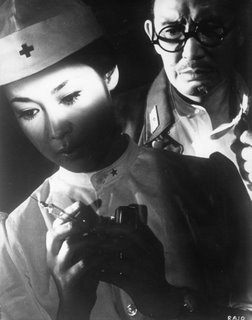 DVD releases of Red Angel (1966) and Blind Beast (1969) by Yasuzo masumura.
DVD releases of Red Angel (1966) and Blind Beast (1969) by Yasuzo masumura. A figure head of the Japanese New Wave, of whom Nagisa Oshima wrote 'a powerful, irresistible force has arrived in Japanese cinema', Yasuzo Masumuru worked prolifically in the 60s, making features at a rate of four a year exclusively for Daiei studios until it went bankrupt in the early seventies. Perhaps it is partly his status as a studio director and partly his generic eclecticism that have caused him to be neglected by the critical attention that was being paid to Japanese cinema at the time, framed as it was by the dominant discourse of the auteur theory. Although he was criticised for his commercial allegiance by his fellow directors, it is hard to imagine a more extreme and volatile personality working within the studio system. Indeed his influence on contemporary figures such as Takashi Miike and Park Chan-Wook seems striking, no doubt going someway towards justifying the recent revival of his work, first as a retrospective, courtesy of the Japan Foundation, and now these two DVD releases from the emerging label to watch Yume Pictures.
Whilst his interest in the convergence of sex and violence links him to his contemporaries Oshima (In the Realm of the Senses) and Imamura (Vengeance is Mine), Masumura's ability to explore transgressive themes, whilst still working with accepted narrative conventions and maintaining a dramatic arc and mode of characterisation that is able to produce a deep emotional reaction, is his alone. Nowhere is this more apparent than in Red Angel (1966), which is arguably his masterpiece. A stunning anti-war film that follows Nurse Sukura Nishi (played by the stunning Wakao Ayako, a Masumura regular) through the hellish environs of the field hospitals of the Sino-Japanese war, Red Angel is absolutely relentless in its portrayals of the horrors of war. In fact it may be one of the most graphically unsettling films from the sixties, and at times it seems incredible that the operating scenes are not gleened from real war footage such is their visceral authenticity. However the incredible scope cinematography soon puts a stop to such thoughts.
Sent to the front line after being raped by a patient, Nishi meets the morphine addicted Dr Okabe, who has become a master at amputating limbs – whether they need to be or not – and has grown deeply embittered at the futility of war and the brutality of humanity. Ashida Shinsuke’s performance as the doctor is brilliantly subtle, and hints at the former idealism of a doctor beneath the hardened, war weary exterior. Imagine the philanthropic protagonist of Kurosawa’s Red Beard (1965), made only a year before, thrown into the battle field where his job is not to save lives so much as to create cripples and you come close to Okabe’s position. In his character the dehumanising effect of war is only too palpable and he views his dependency upon morphine as a placebo not dissimilar from patriotism; a lie that he tells to himself to avoid madness. However his addiction has had the side effect of making him impotent, and so he is at once traumatised and emasculated.
After her former rapist, Sakamoto, appears gut-shot in the ward Nishi agrees to spend the night with Okabe in return for a precious blood transfusion, because she is afraid he will die believing her to have taken her revenge. Although not the best start to their relationship Nishi and Okabe become drawn to one another. Nishi becomes determined to break his habit and restore his manhood so that there love can be consummated, and she succeeds, but only as the Chinese armies begin their invasion of the camp.
The film balances itself between Masumura's usual cynicism and a surprisingly deep humanism, just as the characters struggle to maintain values such as love in the face of war. During a brief spell away from Okabe, Nishi cares for a man who has had both arms amputated by her beloved doctor. These sequences, in which Nishi helps the pathetic soldier to masturbate and then takes him to a hotel and gives herself to him, and by doing so discovers something of herself and her femininity, epitomise the film’s attempt to show the persistence of love in horror, managing to be deeply moving in spite of the situation. In contrast Blind Beast, about a Blind Sculptor who kidnaps a photographic model with the help of his mother in order to pioneer the 'art of touch', is a more pessimistic report on human nature. The Sadean ending plumbs the depths of depravity in a way that anticipates Oshima's deliciously perverted In the Realm of the Senses (1970).
A Full review of Red Angel and Blind Beast is forthcoming on www.firecracker-magazine.com, a site devoted to Asian film, which comes highly recommended.

No comments:
Post a Comment